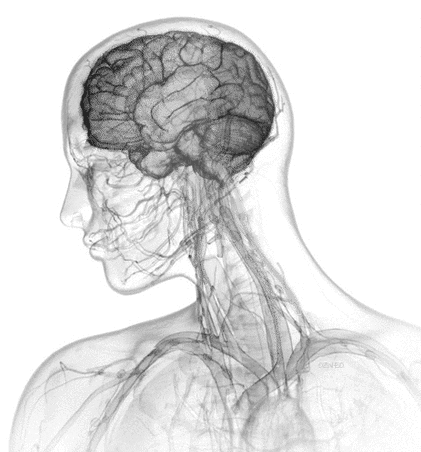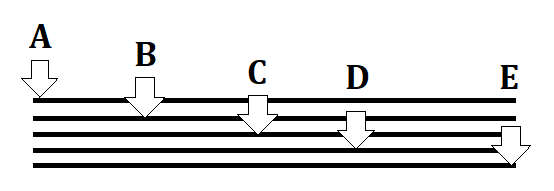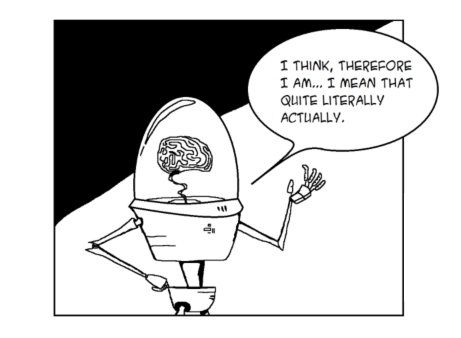
(Animation from GIPHY.com)
Who were you yesterday? Are you the same person today? Who will you be in 1 year’s time? Are you your physical body, comprised of approximately 60 elements? 65% Oxygen, 18% Carbon, 10% Hydrogen, 3% Nitrogen, with a remaining 4% of an assortment of about 56 remaining elements? Are you the chemical and electrical synapses of your brains? Are you the culmination of choices you’ve made? The summation of experience and memory? Are you your virtues? Are you your vices? Are you your likes and dislikes, tastes, sense of humor, the attitude you hold toward the world you inhabit? A great many people, throughout the ages, scattered all over this world have struggled to answer the seemingly simple question, ‘who am I?’
Before getting into topics the likes of religion, spirituality, dissociative disorders/multiple personality disorders, the theoretical Noösphere, the ‘collective consciousness’, our measurable, tangible reality appears to suggest that ‘self’, is singular. Singular in the sense that it is the individual product of the living entity, specifically the individual’s physical brain and the activity therein. Singular and finite, but essentially limited to the physical brain and body (without the use of specific apparatus). In this version of interpretation of self, you are the form and proceeding thoughts and effects of a being (even if conjoined with another) throughout the course of your mortal existence. The moment such an existence ends, with the declaration of death, aside from your physical ‘remains’, existing memory/implications left behind, who you are/were, ceases to be.
So why is it then, that virtually every religion on the planet suggests otherwise? The ‘Afterlife’, The Underworld, Heaven & Hell, The Dreamtime, Reincarnation, ‘Spirits of the Ancestors’, the Immortal Soul? These notions that something ‘goes on’, some part of all beings, transcending mortality arises time and time again, across almost all cultures. The belief in Ghosts, Spirits of the deceased lingering beyond death. The concept of Angels and Demons, beings thought to exist outside or veiled beneath the reality we see before us. Near Death Experiences where individuals report observations that correlate with one another. Much rarer and even more peculiar, NDEs where an individual is pronounced dead, where no brain activity is present, yet upon returning to life, claim to have experienced certain events. (Such as the case of Pam Reynolds Lowery, “In 1991, at the age of 35, she stated that she had a near-death experience (NDE) during a brain operation performed by Robert F. Spetzler at the Barrow Neurological Institute in Phoenix, Arizona. Reynolds was under close medical monitoring during the entire operation. During part of the operation she had no brain-wave activity and no blood flowing in her brain, which rendered her clinically dead. She claimed to have made several observations during the procedure which later medical personnel reported to be accurate.” —Pam Reynolds Case, Wikipedia, Explained in greater detail in a book titled, Light and Death: One Doctor’s Fascinating Account of Near-Death Experiences, by Michael B. Sabom, 2011.)
Someone might suggest, that the reason this idea, regarding existence beyond death, beyond this reality keeps finding common ground is because the alternative terrifies us, as a species. We simply can’t bear the notion that our brief time in this world is all there is and the nothingness from whence we (seemingly) came is all that awaits us, in eternity after we inevitably draw our last breath. So we tell ourselves stories, stories that give a far grander view of things to come than funeral pyres and holes in the ground. But preconceived notions aside, religion and spirituality aside, the question that needs to be considered is, could consciousness exist outside of the brain?
“In [Dr. Peter] Fenwick’s view, the brain does not create or produce consciousness; rather, it filters it. As odd as this idea might seem at first, there are some analogies that bring the concept into sharper focus. For example, the eye filters and interprets only a very small sliver of the electromagnetic spectrum and the ear registers only a narrow range of sonic frequencies. Similarly, according to Fenwick, the brain filters and perceives only a tiny part of the cosmos’ intrinsic ‘consciousness.’”
—Clifford N. Lazarus, Psychologytoday.com, 26th of June, 2019
Fenwick and Lazarus referring to a ‘consciousness’ worded as being intrinsic with the cosmos, a primary attribute of reality itself, as apparent as gravity or light. This resource of ‘consciousness’ being some form of intangible self/collective existing without any basis of physical, tangible, measurable presence, but accounting for what many might refer to as the elusive aspect of humanity, some religions call, the “immortal soul”. The part that transcends all else. The brain ‘filtering’ consciousness, like the filtering of frequency required to tune in to a specific signal. The question then, is ‘where’ or even ‘when’ does this source/signal of consciousness come from? Where does it exist? Assuming it exists in any conventional sense that we can imagine.
Is it possible that consciousness (or something similar), just as it’s insinuated in so many religions (in the form of a soul or spirit), exists beyond the realm of this reality, yet is here all the same? A spiritual, intangible connection to something beyond the observable universe. Something that can be hijacked, the influence of Demons, Angels, Spirits. Something that is (by processes elaborated later) connected to avenues that provide a means of perceiving future events, premonitions, déjà vu, soul mates, fate/destiny. Is this ‘link’ the very means by which God peers into the truest, purest, rawest nature of all living things? If consciousness does/could transcend this reality/dimension, what would be its relationship with the theoretical Multiverse/Omniverse?
“With the proposition of ∞ dimensions, comes an ∞ supply of variables. The basic principals of physics required to keep the some hundred trillion atoms that make up the individual cells in our bodies from destabilization may simply not exist. By the very nature of ∞, there has to be dimensions where that is the case. But by the same principal, dimensions depicting a religious afterlife, planes described in ancient myth and legend, too have a place in the theoretical Omniverse.
In the concept of “shadow dimensions” and “mirror dimensions”, it has been suggested that fragments of a dimension, like ours for instance, can/could be taking place simultaneously in multiple dimensions or shadow/mirror dimensions. For example, the concept of a dimension consisting purely of consciousness, a virtual archive of every sentient being to have ever existed in a specific dimension. Essentially a separate realm, possibly devoid of time, containing what some would call the “immortal soul”. Theoretically, the co-existence of these two (or more) dimensions, could be part of bridging a possible dimensional shift after what we consider to be death.”
When applying the Infinite Monkey Theorem, the prospect of infinite versions of realities to the Multiverse theory:
“There are some, who believe that the Infinite Monkey Theorem is not purely limited to a hypothetical textual outcome. Throughout recent history in science-fiction literature the concept of infinite realities has been explored. The very instant the term ‘infinite’ is applied, then too, endless possibilities must also apply. Just as the endless variables have been addressed in reference to the Infinite Monkey Theorem. Which suggests there are infinite, slight variations of all things even remotely conceivable (or inconceivable! to quote Vizzini from the Princess Bride) throughout various realities or dimensions.
What this could mean, is that there is a reality exactly like this one, only 1 second behind our version of “time”. Then there is another reality, which is 1 second behind that second reality. This could go on infinitely, creating a relative constant of every moment of your (and my) existence, which actually lasts for an infinite amount of time collectively. Meaning, among other things, every second of every one of our existences is perpetually being lived in an incessant and infinite loop throughout the dimensions. That is one version of an infinite possible variations of realities.”

A, B, C, D, E all representing independent realities in a theoretical multiverse. Each of the 5 realities are identical in every single way, but one. The one variable setting these 5 versions of reality apart, is that the entropic changing of state of each universe, the passing of time, is at a slightly different juncture/stage. A, B, C, D, E representing the same point in time, merely if there was an outside omniscient being observing all 5 realities, E is ahead of D, and so on, with A unfolding the same moment last. If you subscribe to both the Multiverse theory, and apply true ‘infinity’ to such a concept, by the logic behind the Infinite Monkey Theorem there is no reason it should be impossible or even improbable that there is an infinity of realities nigh indistinguishable from this one, in some/infinite cases, why wouldn’t ‘time/progression’ alone be the only variable of change?
“What, if some day or night a demon were to steal after you into your loneliest loneliness and say to you: ‘This life as you now live it and have lived it, you will have to live once more and innumerable times more; and there will be nothing new in it, but every pain and every joy and every thought and sigh and everything unutterably small or great in your life will have to return to you, all in the same succession and sequence’ … Would you not throw yourself down and gnash your teeth and curse the demon who spoke thus? Or have you once experienced a tremendous moment when you would have answered him: ‘You are a god and never have I heard anything more divine.’”
—Friedrich Nietzsche, The Gay Science, 1882
The concept of the Eternal Return or Eternal Recurrence unsettled Friedrich Nietzsche (as he expressed in Beyond Good and Evil, 1886). In many works surrounding the idea, the notion suggests the events of this universe unfolding, returning and unfolding again, waves of time, merely going in and out like a tide. The concept is explained in greater detail here, TIME TRAVEL ᴀɴᴅ ᴛʜᴇ 2ɴᴅ ʟᴀᴡ ᴏғ THERMODYNAMICS. But what if throughout the countless realities of the multiverse every fraction of a second of your own life was playing out right now, simultaneously? In the same second your eyes drift over these words, your infant self is exiting your mother’s womb. In the same moment you contemplate that reality, in another, and countless others you die, or a mourner visits your grave site 10 years after you were buried there.
Even those infinite variables, infinite moments that seem so vast to the individual are only a microscopic, minuscule, tiny aspect of a far greater complex system of possibilities. Do these variations, these segments of our identical selves, in perpetual existences, each require an independent soul? Or do the brains that harbor our consciousness interpret it from a plane, a singular dimension? Sometimes revealing glimpses of things perceived to us as future events, yet occurring simultaneously elsewhere. Déjà vu, dreams of future happenings, ‘memories of things yet to pass’, knowing where or what something without any reason to possess such knowledge. (This train of thought could also be applied to the Mandela effect phenomenon where large groups of people claim to remember historical events differently to others. Often argued as distorted or collective erroneous memory, but many believe the phenomenon to be an indication of possible alternate realities/universes, or the merging of such.)
“I remember a vivid dream I had when I was about eight or nine years old, that I’ve managed to remember for all these years. I was wandering through a hospital, I felt drawn to a location, almost like I wasn’t in control of where I was going. Eventually I was standing at the end of a bed where an old man lie. He seemed to be the only person who noticed my presence. He looked at me with a stunned expression, for a moment, until nurses began gathering around him, placing an oxygen mask over his face. I tried to wake up, and I did, but not before seeing the old man die.
Naturally, at the time I was upset, I thought it was some sort of omen about one of my grandfathers. It wasn’t until years later when I was speaking about it with my great grandmother, she suggested that perhaps the old man was me. That I was somehow consoling my future self during my own death. It was an interesting thought, from a woman who after passing away herself, has since visited many of my family members in their dreams.”










